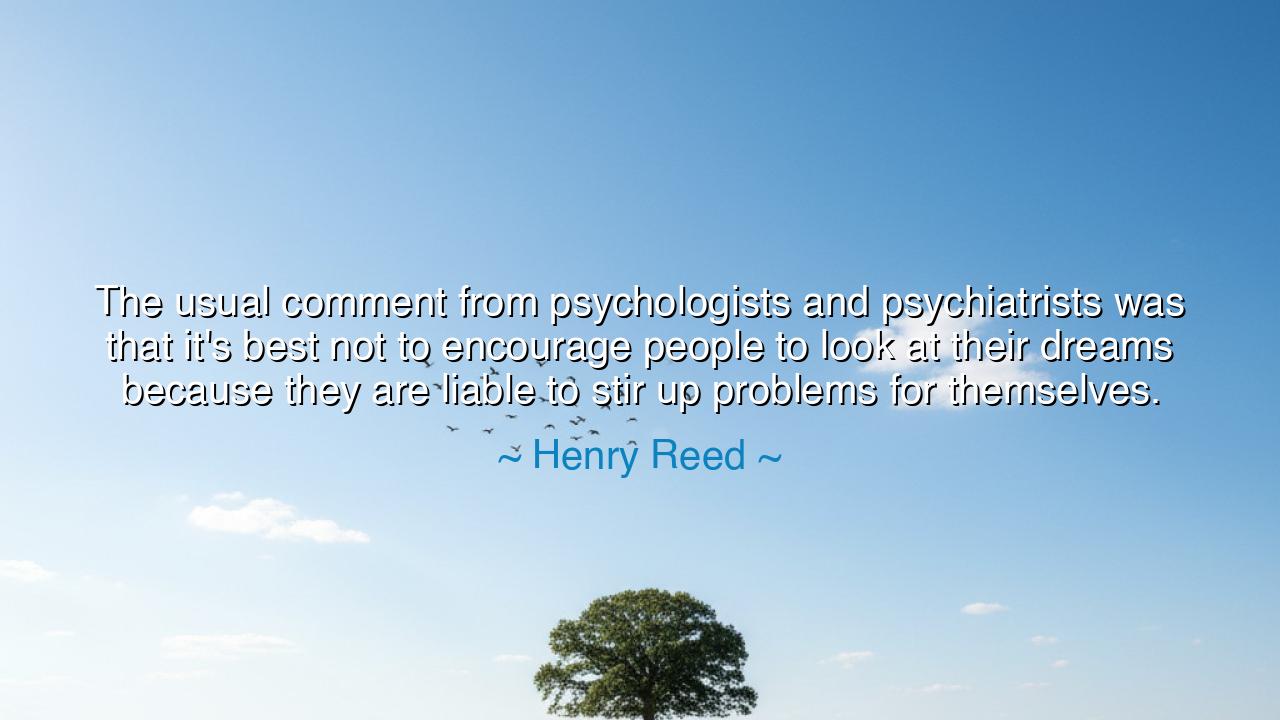
The usual comment from psychologists and psychiatrists was that
The usual comment from psychologists and psychiatrists was that it's best not to encourage people to look at their dreams because they are liable to stir up problems for themselves.






The words of Henry Reed, poet and psychologist, rise like a murmur from the hidden chambers of the mind: “The usual comment from psychologists and psychiatrists was that it’s best not to encourage people to look at their dreams because they are liable to stir up problems for themselves.” In this reflection lies both caution and mystery — a tension as old as humanity itself. For the dream has always been a gate between worlds: between the conscious and the unseen, between the daylight reason and the shadowed realm of the soul. Reed’s words remind us that within that gate lies power — the power to heal, to awaken, but also to disturb. To look at one’s dreams is to risk seeing truths long buried, and truths, like spirits, do not always appear gently.
In the early days of psychology, many sought to bring the dream into the light of science. Yet even then, the wise among them hesitated. For they saw that dreams were not mere illusions of sleep, but reflections of the hidden self — the part of us that dares to speak when the waking mind is silent. Reed speaks of his colleagues’ fear that such introspection might “stir up problems.” Indeed, to study one’s dreams is to awaken what has been repressed, to draw up from the depths the dark and luminous shapes of one’s own psyche. It is no small undertaking. The ancients, too, knew this danger. The Greeks revered Morpheus, the god of dreams, but approached him with humility, for they believed that to interpret a dream was to speak with the divine — and to risk being changed by what one heard.
Yet, consider this: what is life without the courage to face what lies within? The problems that the dream may stir are not punishments, but messages — calls from the deeper self to be acknowledged, healed, and understood. The shadow we ignore grows larger in the dark, but the shadow we face loses its power. Thus, Reed’s observation, though framed in caution, also invites defiance. It is as if he whispers, “Yes, dreams may trouble you — but they trouble you for a reason.” For to awaken is to be disturbed; no one rises from sleep without first being shaken.
Throughout history, many have dared to heed their dreams, and in doing so, have reshaped their lives — and the world. Think of Joseph, the dreamer of the Hebrew scriptures, who saw visions that foretold both danger and salvation. His gift, though feared and misunderstood, became the key to Egypt’s survival in famine. Or think of Martin Luther King Jr., whose “dream” — though not born of sleep — was the expression of humanity’s deepest yearning for justice. His dream, too, stirred up problems — it unsettled nations, it provoked resistance, it awakened conscience. But from such disturbance came light. So it is with the dreams of every individual soul: they may unsettle, but they also illuminate.
Reed’s quote also speaks to the condition of modern humanity — a world that fears silence and avoids introspection. We fill our days with noise, our nights with distraction, lest we encounter the whispering voice within. The psychologists of his time may have cautioned against encouraging dreams, but perhaps it was because they feared what people would find — that behind every ordinary life lies a myth, a story longing to be lived, a truth waiting to be spoken. Dreams are not madness; they are messages in symbolic tongue, offering insight into what the waking mind dares not say aloud.
But make no mistake: to listen to your dreams is to begin a journey of transformation. It demands patience, humility, and courage. For the dream is not always gentle — it may confront you with your weaknesses, your desires, your wounds. Yet in doing so, it offers the medicine of truth. The ancients who interpreted dreams — from the priests of Babylon to the philosophers of Alexandria — did not see them as mere fantasies, but as oracles of the inner world. They taught that the dreamer who faces their visions learns not only who they are, but who they might yet become.
Thus, my children, let this be your lesson: do not flee from your dreams, even when they trouble you. They are not enemies, but mirrors, showing you what your waking eyes have refused to see. Approach them with reverence, as one might approach a wise but demanding teacher. Write them down, ponder their symbols, seek their counsel — for within them lies the architecture of your soul. And if they stir up problems, let them. For from the stirred earth, the seed takes root. From the shaken heart, wisdom grows.
In the end, the words of Henry Reed are not only a warning, but an invitation: that we dare to look within, even at the cost of comfort. For only those who face the storms of the inner world can find the calm beyond them. Dreams are not to be feared — they are to be embraced, for they are the sacred bridge between who you are and who you are meant to be.






AAdministratorAdministrator
Welcome, honored guests. Please leave a comment, we will respond soon